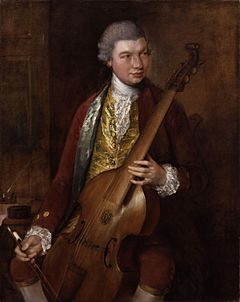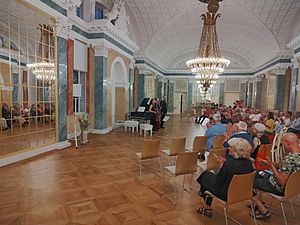Carl Friedrich Abel facts for kids
Quick facts for kids
Carl Friedrich Abel
|
|
|---|---|

Portrait of Abel by Thomas Gainsborough, 1777
|
|
| Born | |
| Baptized | 25 December 1723 |
| Died | 20 June 1787 (aged 63) London, England
|
| Occupation |
|
| Parent(s) | Christian Ferdinand Abel |
Carl Friedrich Abel (born December 22, 1723 – died June 20, 1787) was a German composer from the time just before the Classical music era. He was very famous for playing the viola da gamba, which is an old string instrument. Abel wrote many important pieces for this instrument. He became the music director at the Dresden court in 1743. Later, in 1759, he moved to London and became a special musician for Queen Charlotte in 1764. In London, he started a series of concerts with Johann Christian Bach. Abel wrote about 420 musical pieces, mostly chamber music, which is music for a small group of instruments.
Abel's Life Story
Carl Friedrich Abel was born in Köthen, Germany. His father, Christian Ferdinand Abel, was also a talented musician. He played the viola da gamba and cello in the court orchestra. In 1723, Abel's father became the orchestra director. This happened when the previous director, Johann Sebastian Bach, moved to another city. Young Carl Friedrich Abel later studied at St. Thomas School, Leipzig, where he was taught by Bach himself.
In 1743, Bach recommended Abel for a job. Abel then joined Johann Adolph Hasse's orchestra at the Dresden court. He worked there for fifteen years. In 1759, he moved to England. There, he became a special musician for Queen Charlotte in 1764. Abel gave a concert in London where he played his own music. He used different instruments, including a new five-string cello called a pentachord. This instrument was invented by John Joseph Merlin.
In 1762, Johann Christian Bach, one of J. S. Bach's sons, joined Abel in London. They became good friends. Because of their friendship, they started the famous Bach-Abel concerts in 1764 or 1765. These were the first concerts in England where people could buy tickets for a whole series of shows. Many famous musicians performed at these concerts. Also, many pieces by Haydn were played for the first time in England there.
For ten years, a retired opera singer named Teresa Cornelys helped organize the concerts. She owned a concert hall called Carlisle House in Soho Square. This was a very fashionable place at the time. In 1775, Abel and Bach took over the concerts themselves. They continued until Bach died in 1782. Abel was still a very popular musician. He could play many different instruments, both old and new. He traveled to Germany and France between 1782 and 1785. When he came back to London, he became a main musician in the Grand Professional Concerts. These concerts took place at the Hanover Square Rooms in Soho.
Carl Friedrich Abel died in London on June 20, 1787. He was buried in the churchyard of St Pancras Old Church.
Abel's Musical Works
One of Abel's pieces became famous because people thought it was by someone else. In the 1800s, a symphony written by Wolfgang Amadeus Mozart was listed as his Symphony No. 3. It was even published as Mozart's work. But later, people found out that this symphony was actually written by Abel. Young Mozart had copied it, probably to study how Abel composed music. This happened when Mozart visited London in 1764. That symphony was first published as the last piece in Abel's Six Symphonies, Op. 7.
The first list of Abel's works was published in 1971 by Walter Knape. It was called Abel-Werkverzeichnis and included 233 pieces.
In 2015, new handwritten music by Abel was found. It was music for the viola da gamba. These papers were in a library in Poland. Many of these newly found pieces were published by Edition Güntersberg.
A new, bigger list of Abel's works was published in 2023. It includes 420 pieces and is called the Catalogue of Works of Carl Friedrich Abel or AbelWV. This new list includes many pieces that were found recently.
Main Works by Opus Number
An "Opus number" (Op.) is a way to organize a composer's works, usually by when they were published. Here are some of Abel's main works:
- Op. 1: 6 Overtures or Sinfonias (1761)
- Op. 2: 6 Sonatas for keyboard, and violin and cello (optional) (1760)
- Op. 3: 6 Trio Sonatas for 2 violins and basso continuo (1762)
- Op. 4: 6 Overtures or Sinfonias (1762)
- Op. 5: 6 Sonatas for keyboard, and violin and cello (optional) (1762)
- Op. 6: 6 Sonatas for keyboard and flute (1763)
- Op. 7: 6 Symphonies (1767)
- Op. 8: 6 String Quartets (1768)
- Op. 9: 6 Trio Sonatas for violin, cello and basso continuo (1771)
- Op. 10: 6 Symphonies (1771)
- Op. 11: 6 Concerti for keyboard and strings (1771)
- Op. 12: 6 Flute Quartets (1774)
- Op. 13: 6 Sonatas for keyboard and violin (1777)
- Op. 14: 6 Symphonies (1778)
- Op. 15: 6 String Quartets (1780)
- Op. 16: 4 Trio Sonatas for 2 flutes and basso continuo (1781)
- Op. 16: 6 Trio Sonatas for violin, viola and cello (1782)
- Op. 17: 6 Symphonies (1785)
- Op. 18: 6 Sonatas for keyboard and violin (1784)
Abel Fest
Carl Friedrich Abel was born in 1723. To celebrate his 300th birthday, the city of Köthen held an international festival. It was called the "Abel Fest" and took place over four days in June 2023. The concerts were held in historic places, including the palace and its gardens. A musician named Thomas Fritzsch started this festival. The city also created a special "Abel Prize" that is given out every two years. The first people to receive this prize in 2023 were Leonore von Zadow-Reichling and Günter von Zadow. They were honored for their hard work in finding and publishing Abel's music. They have published more than 150 of his works, many of which were never printed before.
See also
 In Spanish: Karl Friedrich Abel para niños
In Spanish: Karl Friedrich Abel para niños




